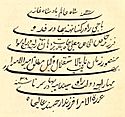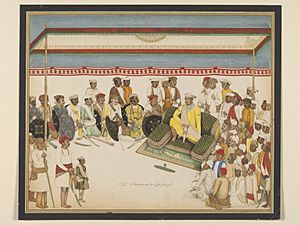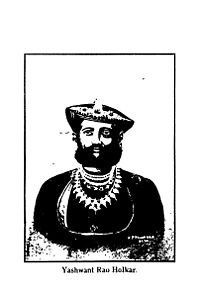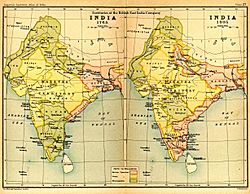Daulat Rao Sindhia facts for kids
Quick facts for kids Daulat Rao Shinde (Sindhia) |
|
|---|---|
| Maharaja (ruler) of Gwalior, Naib Vakil-i-Mutlaq (Deputy Regent of the Empire), Amir-al-Umara (Head of the amirs) | |

Shrimant Daulat Rao Shinde
|
|
| Reign | 12 February 1794 — 21 March 1827 |
| Predecessor | Mahadaji Shinde |
| Successor | Jankoji Rao Scindia II |
| Born | 1779 |
| Died | 21 March 1827 (aged 48) |
| House | Scindia |
| Father | Anand Rao Scindia |
| Mother | Mainabai Scindia (née Angre) |
| Religion | Hinduism |
| Seal |  |
Shrimant Daulat Rao Shinde (also known as Sindhia) was a powerful ruler of the Gwalior state in central India. He was born in 1779 and became the Maharaja (king or great ruler) in 1794 when he was just 15 years old. He ruled until his death in 1827.
Daulat Rao's time as ruler was very important. It was a period when the Maratha Empire was facing many challenges. He also fought in major wars against the growing power of the East India Company. These wars included the Second Anglo-Maratha War and the Third Anglo-Maratha War.
Contents
Becoming the Ruler of Gwalior
Daulat Rao belonged to the Sindhia family, a famous dynasty in India. He became the ruler of Gwalior on February 12, 1794. This happened after the death of Maharaja Mahadji Shinde, who had no children to take his place. Daulat Rao was the grandson of Mahadji's older brother.
He was officially recognized as the ruler on March 3, 1794. He also received important titles from the Emperor Shah Alam II. These titles included Naib Vakil-i-Mutlaq (meaning Deputy Regent of the Empire) and Amir-al-Umara (Head of the Amirs or nobles).
The Maratha Empire and Gwalior
The Gwalior state was a part of the larger Maratha Empire. This empire was started by Chhatrapati Shivaji Maharaj in the 1600s. Over time, the real power in the empire shifted from the Chhatrapati to the chief ministers, called peshwas. The Maratha Empire grew much larger in the 1700s, taking over lands from the Mughal Empire.
As the empire expanded, Maratha army leaders were given the right to collect chauth. This was a type of tax or tribute from the lands they conquered. Daulat Rao's ancestor, Ranoji Sindhia, had conquered areas like Malwa and Gird from the Mughals. This led to the creation of the Gwalior state. It was first based in Ujjain, but was named after the strong fort of Gwalior. Daulat Rao's wife, Baiza Bai, was also a very smart and influential woman who helped manage the state.
Challenges to Maratha Power
A big defeat for the Marathas happened at the Third Battle of Panipat. This battle stopped their expansion towards the northwest. It also caused the Maratha Empire to become less centralized. Power was then shared among five main Maratha families:
- The Peshwas of Pune
- The Sindhias of Gwalior
- The Holkars of Indore
- The Pawars of Dhar and Dewas
- The Bhonsles of Nagpur
- The Gaekwads of Baroda
Mahadji Shinde, Daulat Rao's predecessor, had made Gwalior a very strong military power. He built a modern army with the help of a French commander, Benoît de Boigne. Because of this, Daulat Rao saw himself as a very important ruler in India, not just a part of the Maratha Empire.
Conflicts with the Holkars
During Daulat Rao's rule, there was a lot of confusion and conflict within the Maratha states. This was due to the death of the young Peshwa, Madhavrao II, and the rise of Yashwantrao Holkar, another powerful Maratha leader. Daulat Rao tried to gain more power and land. He took territory from the Maratha Ponwars of Dhar and Dewas.
However, Yashwantrao Holkar's growing strength worried Daulat Rao. In 1801, Yashwantrao attacked Ujjain, Daulat Rao's capital. He defeated some of Daulat Rao's troops and demanded a large sum of money from the people. Later, Daulat Rao's adviser, Sarjerao Ghatge, got revenge by attacking Indore, Yashwantrao's city. He caused a lot of destruction there.
In 1802, Yashwantrao Holkar defeated the combined armies of Daulat Rao and Peshwa Bajirao II near Pune. This period became known as the gardi-ka-wakt, or 'period of unrest'. During this time, central India suffered greatly from the constant fighting between the armies of Sindhia and Holkar. They were also joined by groups of raiders called Pindaris. The French commander of Gwalior's army, Benoît de Boigne, had retired in 1796. His replacement, Pierre Cuillier-Perron, caused unhappiness among the soldiers by favoring French officers.
Treaties with the British
On December 31, 1802, the Peshwa signed the Treaty of Bassein. This treaty recognized the East India Company as the most powerful force in India. Daulat Rao's constant delays in negotiations led to conflicts with the British. He suffered major defeats in battles like Ahmadnagar, Assaye, Argaon, Asirgarh, and Laswari.
On December 30, 1803, Daulat Rao signed the Treaty of Surji Anjangaon. In this treaty, he had to give up many of his lands. These included areas between the Yamuna and Ganges rivers, South Haryana, and the Bharuch District. He also lost the forts of Gwalior and Gohad. This caused a lot of anger and led to the British Resident's camp being robbed and the Resident being held captive for a short time.
In 1805, under a new British policy, Gohad and Gwalior were returned to Daulat Rao. The Chambal River became the northern border of his state. Some claims on Rajput states were also removed. The British agreed not to make treaties with certain states that paid tribute to Sindhia.
In 1811, Daulat Rao conquered the nearby kingdom of Chanderi. In 1816, he was asked to help stop the Pindaris, who were causing trouble. After some hesitation, he signed the Treaty of Gwalior in 1817. He promised to help fully, but he did not always keep his word. He allowed the fort of Asirgarh to remain under his control, even though the treaty said it should be given up. A new treaty in 1818 changed the borders again, and Daulat Rao gave up Ajmer and other lands.




